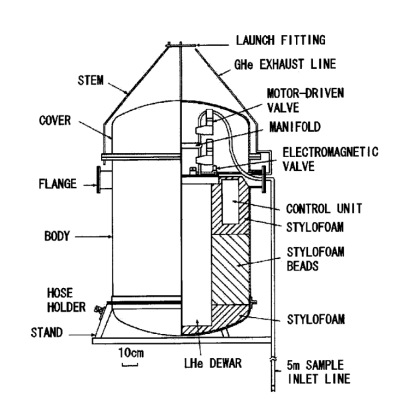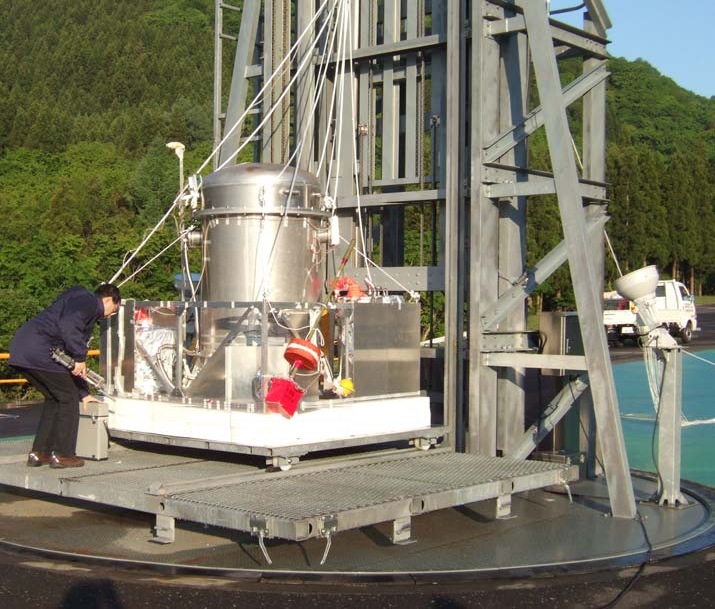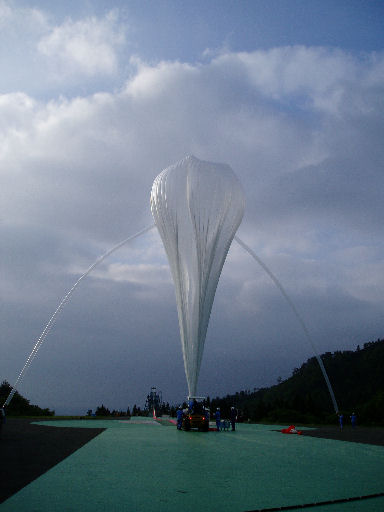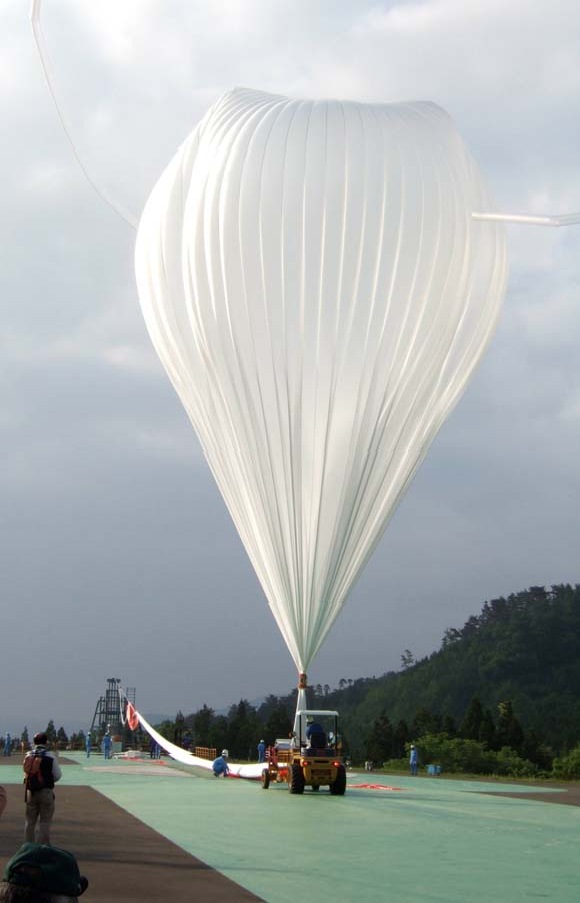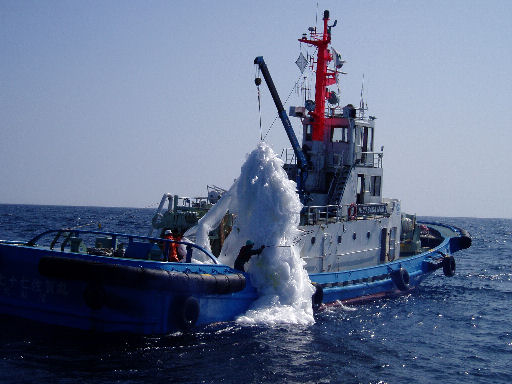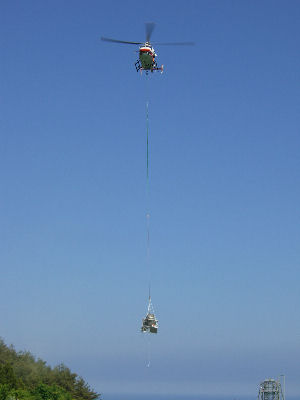Purpose of the flight and payload description
This flight was part of an air sampling program started at the Institute of Space and Astronautical Science (ISAS) of Japan by a group led by Prof. T. Itoh in 1978. The objective of the program was to obtain stratospheric and tropospheric air samples above Japan first using a balloon-borne grab sampler and later a cryogenic sampler. After each flight those samples were distributed among collaborating scientists whom analyzed minor constituents of the stratospheric air using precise analyzers in their laboratories.
A schematic diagram of the cryogenic sampler is shown at left (click to enlarge). It consisted mainly of 12 stainless-steel-sample containers, a liquid helium dewar, a receiver, a transmitter, a control unit and batteries; all these components were housed in an aluminum chamber pressurized at 1 x 105 Pa. The volume of each sample container was about 760 ml and the inner wall of each container was electrically polished. A motor-driven metal-to-metal seal valve was attached to each sample container. The other end of the motor-driven valve was connected to the sample intake through a manifold. Air samples were introduced into the containers through a 5 m bellows tube, of which one end was located 4 m below the bottom of the sampler to avoid possible contamination from it.
All parts were made of stainless steel and connected to each other with metal gaskets. After assembly, the leakage of the system was confirmed to be minimal by a mass spectrometer leak detector, and all tubing including the sample containers were evacuated for longer than one month to make their insides clean. Prior to air sampling, a similar evacuation was made for about one week, and then the valves were closed and the sample containers were cooled to -269º C by filling the dewar with liquid helium. Total weight of the sampler was about 260 kg.
To minimize contamination from the balloon, the sampler was suspended about 120 meters below the balloon by a stainless steel wire and air samples were collected at assigned heights during the descent of the balloon. The maximum height of air samples collected ranged from 25.0 to 35.0 km, depending on the size of the balloon used. At each assigned height, the motor-driven valves were opened and closed using a telecommand. The amount of air samples collected was approximately 25 liters. To avoid intrusion of contaminated surface air into the sample containers, the stainless-steel bellows tube was also evacuated together with the containers and its evacuation was broken when the balloon ascended to the maximum height.
Once the balloon flight was completed the sampler detached from the balloon and descended under his own parachute. The sampler was recovered within an hour of the impact in the sea surface. Back in the laboratory, the sample containers were laid for about one month to ensure that respective components ofthe air samples were mixed well in the containers before proceeding to analyze them.
As an additional payload was mounted in the aluminum gondola a second sampling unit known as JT-Sampler to be launched in Antarctica by the 49th Japanese Antarctic Research Expedition. The new compact cryogenic air sampler use a cooling device called the Joule-Thomson (J-T) minicooler. The J-T minicooler can produce liquefied neon within 5 seconds from high pressure neon gas precooled by liquid nitrogen. The sampler employs liquid neon as a refrigerant to solidify or liquefy sampled atmospheric constituents being capable of collecting about 3 and more than 7 L STP of air at 25 and 120 hPa, respectively, which corresponds to about 25 and 15 km above ground within 240 seconds, respectively.
During the flight a comprehensive performance evaluation was made of the new sampler. As a result, it was confirmed that this device executed a preset atmospheric sampling sequence at an altitude of 20 km, achieving the intended purpose.
Details of the balloon flight
Balloon launched on: 6/4/2007 at 6:00 jst
Launch site: Sanriku Balloon Center, Iwate, Japan
Balloon launched by: Institute of Space and Astronautical Science (ISAS) / Japan Aerospace Exploration Agency (JAXA)
Balloon manufacturer/size/composition: Zero Pressure Balloon model B100 100.000 m3
Flight identification number: B100-17
End of flight (L for landing time, W for last contact, otherwise termination time): 6/4/2007 at 13:30 jst
Balloon flight duration (F: time at float only, otherwise total flight time in d:days / h:hours or m:minutes - ): 7 h 57 m
Landing site: 35 km from the shoreline of Kamaishi, Japan
The balloon was released at 6:00 local time and after a first climb to 13 km the telecommanded valves were operated to slow down the ascent speed and start the air sample collection. A little more of 4 hours after the launch the balloon finally reached the ceiling level at 34.6 km and was located 100 km east of Sanriku. At that point was activated the gas valve, starting a slow descent and continuing the sampling of the atmosphere during this phase. Finally, the balloon was separated from the payload, and both were succesfully recovered from the sea 35 km from the shoreline of Kamaishi.
External references
- Cryogenic Air Sampling Group homepage Tohoku University website
- Details of the mission (In Japanese)
- Gravitational separation in the stratosphere - a new indicator of atmospheric circulation Atmos. Chem. Phys., 13, 8787-8796, 2013
- Japanese Balloon Program J. Phys. Soc. Jpn. 78 (2009) Suppl. A, pp. 97
2663If you consider this website interesting or useful, you can help me to keep it up and running with a small donation to cover the operational costs. Just the equivalent of the price of a cup of coffee helps a lot.

